Butterfly pea flowers are incredibly popular right now.
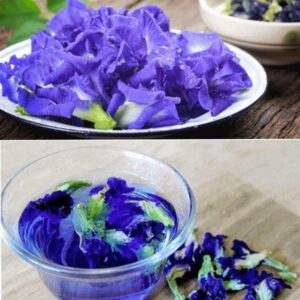
From beautiful, violet gins to butterfly pea smoothies, these stunning, edible flowers are finding their rightful place in the kitchen garden. Butterfly pea is native to India and Southeast Asia, but can be grown as an annual throughout North America.
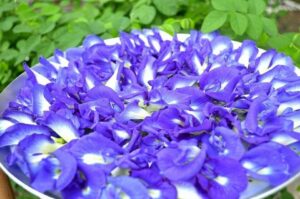
This exotic-looking, creeping vine adds a fairytale flavor to the average kitchen garden. Its brilliant bluish-purple blooms look magical against their vining, soft, green leaves.
Let’s get to know all about growing butterfly peas.
Introduction to Blue Butterfly Pea Vine Plant
Clitorea ternatea is a fast-growing tropical legume that is a stunning member of the garden. Butterfly pea plants can grow six to ten feet tall and spread slightly over three feet
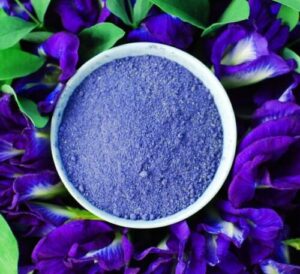
After a few months of growth, butterfly pea plants explode into an array of gorgeous flowers. Depending on the cultivar, these flowers can measure between an inch to three inches across.
Full sunlight allows the plants to produce the most flowers, but butterfly pea plants can also thrive in partial sun. Perennial in USDA Growing Zones 9-11, butterfly peas do best in temperatures above 60°F.
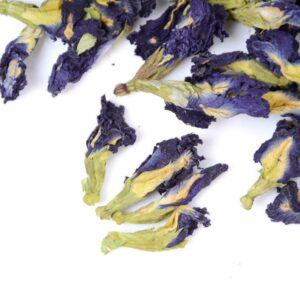
That said, they can grow as an annual in any climate where temperatures won’t dip below 60°F for at least four months of the year.
The flowers resemble a butterfly or (as indicated in the botanical name Clitoria) female genitalia. The flowers are scentless and mildly flavored and bloom in the morning
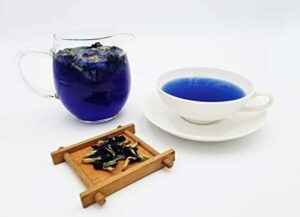
The flowers can be dried as a soothing, nervine tea or added to clear liquors to produce a gorgeous purple, floral flavored drink. The purple liquor turns bright pink when citrus or tonic water is added.
Popular Cultivars
Since butterfly peas have become popular recently, quite a few stunning cultivars are popping up in North America.
Blue Queen
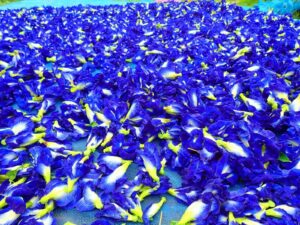
This lush, flower-laden cultivar produces deep blue, double blossoms. It can grow up to 6 feet tall – thick with cascading vines and color-rich flowers. Blue Queen is an ideal cultivar for gardeners who want to harvest a lot of flowers.
Lavender Queen
Easier to grow in northern climates, Lavender Queen produces soft, lavender-colored flowers that give a more muted color to drinks and food. It is just as edible and medicinal as the brighter blue flowers but quieter in tone.
White Queen
This pale flower is a pure, white version of the butterfly pea flower. While it won’t dye anything, White Queen is gorgeous and edible. The large, white, double-petaled flowers look beautiful on the vine and in your teacup.
Planting Butterfly Pea Vines
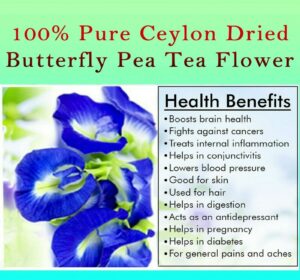
While Clitorea ternatea grows quickly and easily, it has a reputation as a finicky germinator. The seeds have a thick, waxy outer coating that can make germination hard.
When you’re starting butterfly pea seeds, nick each seed once with a knife and soak the seeds in warm water for 24 hours before planting.
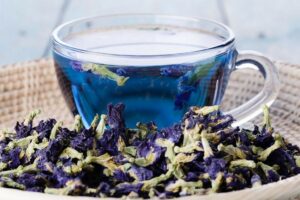
In spring & summer, you can start these seeds outdoors as soon as the soil is warm enough. In winter, start these seeds indoors. Seeds should germinate 3-6 days after planting. However, if the ground is cool, germinating can take up to two weeks.
When starting indoors, use a warming mat to start the seeds. Butterfly peas are a tropical plant. It germinates best in warm weather. Soil temperatures between 80-86°F produce the best and most consistent germination.
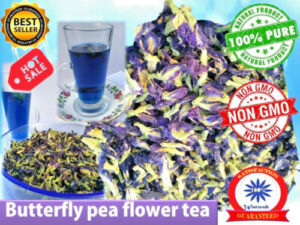
When the young plants are fully established and about six inches tall, transplant them outdoors after hardening them off.
Don’t attempt to move your butterfly pea plants outdoors until all danger of frost has passed and the soil is warm. Before transplanting, harden the seedling off by allowing them to spend the days outside and bringing them inside at night.
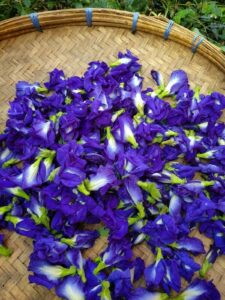
Preparing the Soil
Whether you start the seeds indoors or outdoors, butterfly peas appreciate well-prepared soil. They prefer rich, sandy soil with a neutral to slightly alkaline pH. But you don’t need to amend the soil with nutrients.
Like many legumes, butterfly peas improve the soil themselves. These peas draw nitrogen from the atmosphere and build nutrients into the soil
In fact, you can use butterfly peas as a cover crop, similar to clover, and rotate it through the garden to boost soil nutrients and improve the soil overall.
Growing Butterfly Peas
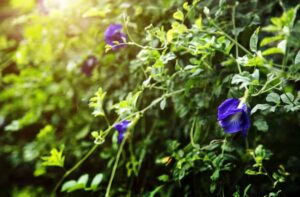
Before planting or transplanting your butterfly peas, give them the best chance at success by planting in moist, well-draining soil. Mix a little into the soil if you have some compost or manure.
Plant in full sun when possible. Butterfly peas can thrive in full and partial sun as long as the soil has plenty of sunlight and warmth.
Spacing
Allow about 8-10 inches between butterfly pea plants. While they can be left to trail along the ground, butterfly peas do best with something to climb on.
Unlike many vining plants, butterfly peas aren’t aggressive to their neighbors. They’ll climb eagerly, but they rarely choke out their neighbors. Pair this plant with basil, lemongrass, or rosemary.
Water
When butterfly peas are young and newly established, keep the soil moist. Don’t overwater this plant. But water regularly enough to keep the soil from drying out completely. When the plant is established in the garden, it’s drought resistant, so only water when they’re young or in arid weather.
Make sure the soil drains well, and don’t over-water the plants. Butterfly peas can tolerate almost anything except waterlogged soil.
Growing Season
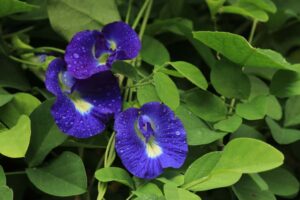
Butterfly peas need about 90 days between germination and flowering. Once flowering begins, it’s abundant and long-lasting. Butterfly peas are perennial in their native region and can be grown as perennials in tropical and sub-tropical areas (Zones 10-11). In cooler growing regions, your butterfly peas are a stunning annual.
Common Pests and Diseases
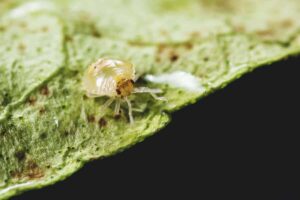
Butterfly pea plants can suffer from spider mites and aphids. If you notice signs of mites or aphids on your plants, treat the leaves with neem oil once every two weeks until the pests are gone.
Overwatering can cause the roots of your butterfly pea plant to rot. Overwatering can also cause problems with caterpillars and grasshoppers, which will attack your plant because it’s weak and unhealthy.
Harvesting Butterfly Pea Flowers and Pods
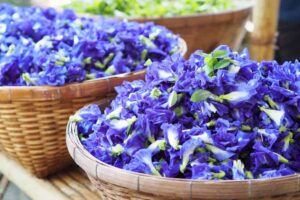
Once the flowers bloom, they’re harvestable for a day or two before starting to fade. Allow a few flowers to stay on the vine if you want to have pea-pods and seeds to save. Once the flowers are harvested, they’re easy to dry on a screen.
Let them sit in a dry place, out of the sun, until they’ve dried out. This usually takes about one to two weeks. Then, store them in a sealed jar.
The young pea pods are edible as well. Pick the pods while they are small and tender, then cook them before eating. They’re most often cooked in curries or tempered and fried. The pods are not very flavorful, though. They taste best when incorporated into flavorful Indian and Southeast Asian dishes.
Butterfly pea flowers, like daylily flowers or squash blossoms, can also be battered and fried. Lemon juice can add nuance to the light, floral flavor of the blossoms.
Medicinal Uses of Butterfly Pea
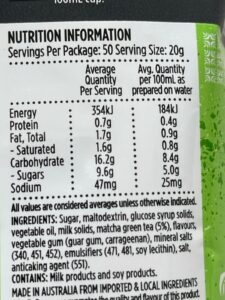
While butterfly pea flowers have been used for centuries in traditional Chinese and Ayurvedic medicines, it’s only recently come to the attention of Western herbalists.

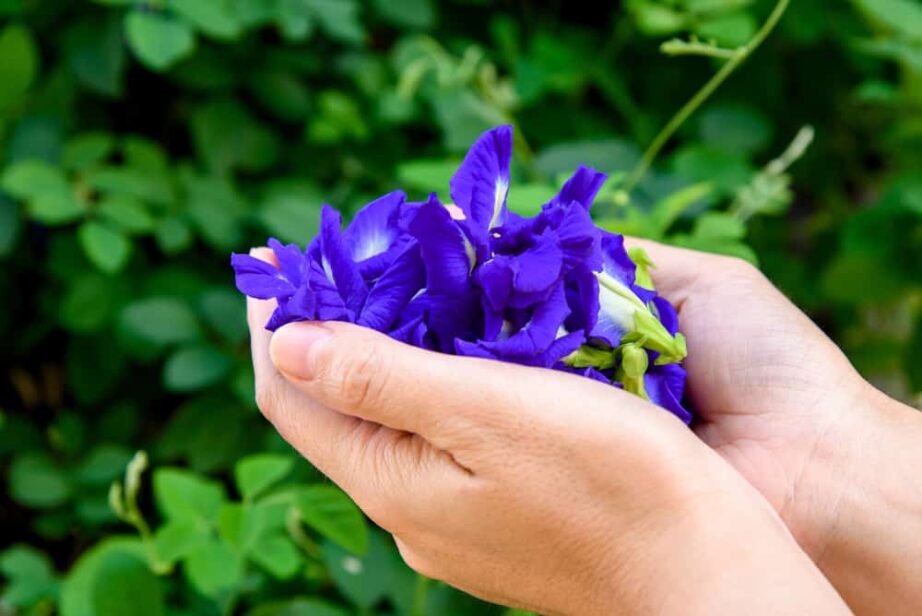
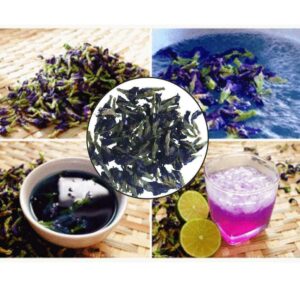
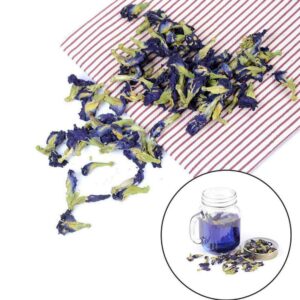
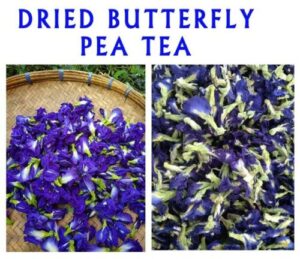
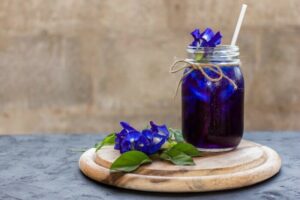
 Any questions or if buying, contact me
Any questions or if buying, contact me
Recent Comments